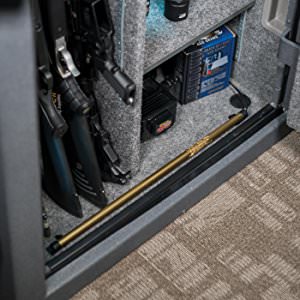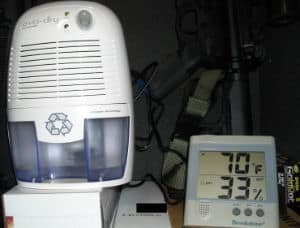If you leave on the East Coast, you must know what humidity means. And maybe you have a small house, maybe you live in an apartment, or your house is already full. Then, the only places you thought about to install your safe were your garage or your cellar. You know fear or have already discovered humidity in your safe. And with humidity will come bad smell, mold and mildew, rust and corrosion… Everything in your safe will suffer from moisture.
What can I put in my safe to keep moisture out? 1. You can start with silica gel, rice or specially made products. But those products need to be changed regularly. 2. You can try electrical devices inside the safe: it raises slightly the temperature inside to prevent moisture. 3. You can use an electric dehumidifier: small for inside or bigger to put outside, close to the safe.
If you want to regain space in your house, installing your safe in your cellar or garage is worth considering. But then, you have to mitigate the effects of humidity on everything you might store in your safe. And a safe is here to stay. This is why you shouldn’t take the risk and store your valuables in a humid safe where they will definitely suffer from moisture. Here is what to do to fight moisture in a gun safe.
How can I fight moisture in a home safe?
These are my recommendations on how to keep moisture out of your safe. This is what I did.

- Check hygrometry level. First, you absolutely need to know the humidity level of your safe in order to fight it. And to know if you need to fight it at all. There are several small devices useful and quick to use such as a humidity gauge or a gauge with smart sensor with alerts that connects to your smartphone.
- In order to fight humidity, there are several products to put inside your safe. There are several tricks that you can read here and there that I don’t recommend such as putting rice in a bowl inside the safe. (Rice uncooked of course..)
- Calcium chloride-based products such as a Damprid. The main advantage is that you don’t need electricity. You refill your container when there is no crystal left. Just throw away the water and refill the crystals. You can choose the size of the container that you want in order to put it close to your safe or inside. If it is inside though, you mustn’t forget to check regularly your container.
- Cat litter. I didn’t automatically think of that. But it can be a cheap alternative as well. Pet litter can help to absorb moisture and to remove smells of mildew. A litter doesn’t have to be expensive to work well, almost any will do.
- Silica gel packets. These can be very useful. You can reuse them because they can be found already in many packages or parcels you receive. But you can buy more if you need more, because Only for small safes, of course, otherwise you will have to change them too often.
- A Goldenrod is a good device to prevent humidity in a really simple way. It raises the temperature of the safe slightly for example 6 to 8°F. And this alone can get the humidity down enough to use your gun safe with no corrosion and protects papers, ammunition from mildew. It is better, of course, to install the device at the bottom of the safe as heat naturally rises. It is easier to use it in a safe which has a 110v outlet inside. But many safes which can be anchored to the wall are drilled or pre-drilled in the back: use that hole to install electricity inside. And it works well together with silica gel canisters. This is a no-brainer if you have a big gun safe with plenty of room inside. With this Golden Rod, you do not need to worry about humidity in your safe. And if you use it together with other products such as silica gel, you do not need to change them as often, maybe 3 to 4 times less, and that is less expensive and less hassle. There are several sizes of GoldenRod Gun Safe dehumidifiers. You will find the right size that will fit in your safe.
- Small dehumidifier that you put inside the safe. For example a mini dehumidifier. It is small enough that you can put it inside the safe if you have an outlet or a hole. It removes damp mold and moisture in small spaces. You can also have it close to your safe. It is energy efficient with low power consumption because it uses advanced Peltier technology and stops when full. As a drawback to Goldenrod, you need to empty the water tank (180 oz) when full. So, for a mini dehumidifier, it does the job provided you don’t want to remove damp from the whole garage with it. It is best for inside the safe itself.
- Big Dehumidifier for the garage itself. This can be the way to go if you want to take advantage of your dehumidifier to keep moisture out of your whole garage. This 70 pint dehumidifier has a capacity good for up to 4,500 Sq Ft rooms and is programmable. It can be purchased on Amazon and provide a really good value. The compressor technology is energy star compliant. It gives better air by preventing mold, mildew, dust, allergens, and odors. Your garage itself will be more comfortable, not only your safe. You will be better in your garage to work, store anything including food. It might be more expensive upfront, but will be easier to maintain or operate than a small dehumidifier inside the safe. And you won’t have to think to open your gun safe to change your silica crystals regularly. The size and power of this unit will provide a noticeable result that you can measure on your humidity gauge. It first has to run 24/7. Then automatic is good even to bring the humidity down south of 50%. And you regain a room in your house.
How to have electricity in my gun safe to install a dehumidifier?

Fortunately, more and more safe manufacturers (for example Cannon, American Security or Liberty) have built their safes with electrical outlets already installed. If not, they offer an electrical adapter kit.
It is really easy with the outlet, you have nothing to do but plug the dehumidifier and it starts immediately.
If the safe is prepared and pre-drilled, it is not much more complicated to install an adapter kit to get electricity inside your safe.
If your safe provides neither an electrical outlet nor adapter kit, you still can sometimes lead a wire sometimes through a hole pre-drilled in the back of the safe. This hole is used to anchor the safe to a wall. But if you anchor the safe on to the concrete ground you don’t really need the back hole and you can then use it to that purpose.
Keep in mind that the safe will be less fireproof with a hole on the back, even small, and an electrical wire coming inside.
If you have electricity inside your safe, you will have the following benefits as a bonus: you will be able to plug in other items like chargers, watch winders, lights, etc. This is something to definitely consider.
How humidity can affect a home safe content?
- How humidity affects paper?
Paper reacts slowly but badly with humidity. First, it becomes soft and flabby. It doesn’t seem to be as strong. It might just tear apart if you need to read what is written on it. And then, there are worse things that will happen to paper. It will dampen, store humidity in its fibers. There will be mold and mildew.
This is very bad all the more so as you have stored your most precious papers inside the safe: cash, stocks and bonds certificates, important invoices, passports, will and testament, annual tax returns, property titles and other things you definitely should have stored in there. If you are not sure anymore that your most important papers will keep for many years, how can you use a safe altogether? This is too important: humidity should be measured and fought if needed. - How humidity affects electronics?
The main problem with electronics and humidity is that contacts are made of brass and also electric circuits. And copper or brass have a kind of corrosion often called verdigris that prevents proper contact to be made. The electronics of the lock are not powered by the battery and can’t operate the door. And that is bad. Corrosion can even cause shorts in any circuit and fry it. If you can’t open your safe anymore, it can be expensive. Remember: a safe is made not to be open. A locksmith or a construction man can be expensive if they have to come to your house to help. If the lock is broken, the only way to open the safe will be to drill or cut its door. Not only you will have to pay for the work, but you will likely have to pay for another door, or a new safe itself. Which means starting all over again: choosing a safe, buying it, moving it, installing it and … dehumidifying it! That is bad for the safe itself, but also for everything that is electronic and stored inside: camera, hard drive, USB key, SD card, and so on. It is so important to fight moisture to prevent your safe to become inoperative. - How humidity affects guns?
In a non-heated room or in a room without climate control, the temperature can vary a lot. Cold metal can be more easily covered with condensation, moisture and then rust. Your gun will look bad but also and more importantly risk malfunctioning. This can make the difference between life and death. A clean and oily gun is a good start as it will alleviate rust or even as much as prevent it. But the tips below to prevent moisture from the start shouldn’t be overlooked. - How humidity affects ammunition?
If you use quality factory ammunition which is sealed, there can’t be any problem. The problem is when people reload their own ammunition and buy inexpensive primers that aren’t sealed. This allows moisture to get inside and cause the round not to function. Brass, as we have already seen above, do not like humidity, as well as casings and primers. And it is not safe. Bad ammunition can cause misfires. And a failure to fire is one of the worst outcomes when using a gun. It can also damage firearms and even hurt the person firing the gun. This is why it is really important to store your ammunition in a good as dry as possible environment. It can definitely have severe consequences. - How humidity affects coins?
Depending on the metal used in the making of the coin, it will tarnish, or have once again verdigris if made of bronze. This is only aesthetic. But if you want to keep coins in good condition without too much work to polish them again, fighting humidity is crucial. - How humidity affects gold, silver, and jewelry in general?
How about gold bars? I hope your home safe is full of gold bars! Mine is not, yet. I cannot give you advice on how to polish gold bars and keep them from mold, but the good news is Gold is a noble metal. Together with silver. Those metals won’t be corroded or oxidized. Be reassured, you won’t have to polish regularly you’re gold bars. As for jewelry, it won’t corrode or oxidized per se but might tarnish and not be as bright as it should. A safe storing jewelry shouldn’t be humid. Thus, you will be able to choose any necklace or ring and wear it instantly without planning and polishing!
How humid is too humid for a safe?
Hygrometry is the amount of water vapor present in a volume of air. It is not visible unless vapor starts to condensate into small drops in the air, in which case it can be seen in a sort of fog.
Hygrometry is relative: a hot air contains more water vapor than a cold air. That is why differences in temperature can generate condensation:
- In the afternoon the air in your garage is warm and you open your safe. Warm air goes inside. Then the temperature goes down. The air is trapped in your safe and gets colder. Cold air can’t hold as much water vapor in the form of gas: it has to return back to the state of water and condensates in the safe. And moisture forms against the walls.
- You put your hot gun in the safe together with warm air. And again, the air comes in hot and becomes cold again. Hence moisture forms.
Here in the United States, the most humid cities are generally in the Eastern U.S. The dew point is higher. Coastal Florida and Texas have the highest dew points even though the air does not feel humid.
In a broad sense, hygrometry should be between 10% and 50% and should be measured. Differences in temperature should be avoided as much as possible. If the room is not heated or climate-controlled, this is how it is possible to mitigate, fight and even eliminate humidity in a safe.
Some rooms like cellars, garages, etc. can have their hygrometry level as high as 75% which is not good not only for storing a safe but also life in general. Fighting humidity successfully is good for health and hygiene, food, and the value of the house itself. A good dehumidifier can allow you to regain another room where you can store many things safely at a humidity level lower than 50%.
I have spent lots of time documenting on the subject because I didn’t want to make any mistake for myself. This is why you might read further my article on why installing your safe in your garage is worth considering.

